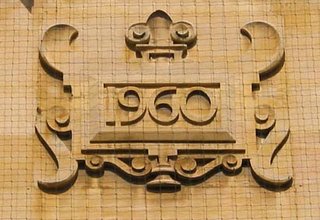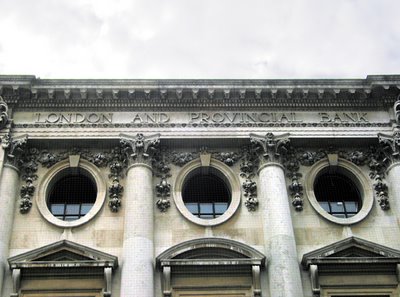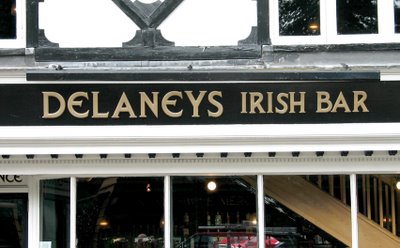
Near the top of London Street you will find the Bowhill & Elliott shoe shop. They are the last shoe manufacturers in Norwich, still making slippers in their downstairs workshop. The lettering is a classic 1920s modernist sans serif, similar to Gill Sans Bold, elegantly letterspaced. This could have been in place since the 1930s, but similar letterforms were in wide use until the early 1960s, when they fell out of favour for a couple of decades. Note the restrained and undersized ampersand. This lettering (and its spacing) implies quality with a slight sense of reserve.

Further down London Street on the same side as Bowhill & Elliott you will find a tall sandstone building (the Woolwich) with three date plaques carved high up on its facia. These presumably represent the dates of the original build (1844), the first remodelling (1900) and the most recent facelift (1960). My guess is that the two earlier dates were both carved in 1900 to commemorate

the new look of the building (the detailing of the cartouche is very similar on both) and that the third was added in 1960 (the details are different: a slightly more robust numeral; a plinth ornament at bottom centre instead of a bifurcated one; a more generous fleur-de-lys on top with downturned outer leaves; upswept instead of downswept horns on top of the cartouche). Very nice work, whenever it was done.

On the opposite side of London Street, Opie Street slopes up towards Castle Meadow. Opie Street was named after Mrs. Amelia Opie (1769-1853), who was a prominent Norwich socialite and author, friend of Mary Wollstonecraft, who later became a Quaker and was a major social reformer and worker for charity in the early 19th century. Her statue sits rather uncomfortably on top of a shopfront on the right of the street.

Of course, the street may well have been named after her husband, the painter John Opie (1761-1807) but I am sticking with Amelia.
When you enter Opie Street, immediately on the right there is a carved limestone tablet recording the sedan chair service that used to operate from the spot. Nice to know that the street used to be called 'Devil's Alley'. Did this have satanic connotations or did it refer to 'Printer's Devils'? The lettering is nicely carved but with some erratic letterspacing caused by the generous width of the 't'. The sloping crossbar on the lowercase 'e' (a humanist typographical feature from the mid-15th century) indicates that this may have been inscribed around 1920, when such typefaces were being revived, notably Centaur by Bruce Rogers. Some other typefaces that feature this are Italian Old Style, Clearface and William Morris's Golden Type.

At the top of Opie Street, on the left, there is a spectacular piece of opulently carved Victoriana above and around the door to Castle Chambers. Wonderfully sculpted tiles over the nameplate feature a central panel with '1877' in intertwining and rather gothic numerals (the flat-topped 8 is often found in work from this period). The 'Castle Chambers' letterforms themselves are powerful in intent and relatively consistent, although they feel rather lumpy, especially in the curved letters (C and S). As with the Art School facia, this suffers from over-tight letterspacing, which has forced the signmaker to use an uncomfortably compressed M.

Further down London Street, on the right, there is the fine shopfront of Winsor Bishop, goldsmiths.

(07.09.06) This window looks like a jewel box, due to the style and impact of the ornate and gilded letterforms, beautifully incised and protected behind glass. Below is a close-up of the paired numeral panel.

These numerals and the 'Winsor Bishop' lettering are standard 19th century slab serif letterforms, also known as 'Egyptians', due to the concurrent popularity of Egyptology at the time that they first appeared. The 'Watchmaker' form is quite different; a more decorative and spindly letter, especially in the looped centre strokes of the W and M. Looks to have been made in the late 19th century.

(30.09.06) On the left of London Street, opposite Swan Lane, is Gap. The sign in the window features their logo, which is a condensed 'Modern' or Didone face.

These typefaces are distinguished by their strong contrast in stroke weight: thick thick strokes and thin thin strokes, similar to Bodoni and Didot, faces designed in Italy and France at the end of the 18th century. They are often used by the fashion industry (e.g. the ELLE masthead) as they have an elegant air, especially when condensed to this extent. This looks to have been specially designed by a logo specialist rather than use an off-the-peg typeface.
Look up to the top of the building and you will see its more floridly classical origin in the late Victorian era as the London and Provincial Bank. Not too badly spaced, but inconsistent design of the A (differing crossbar heights).

Across London Street is Habitat. Just in case you miss it, the name is repeated at least four times, at different heights and sizes, all over the unlovely building.



Luckily, the Habitat logo uses a particularly lovely typeface: Baskerville Old Face, sometimes called Fry's Baskerville. It was designed in the late 18th. century, inspired by John Baskerville's original of c. 1755. I have always thought that this was a good choice for the Habitat logo, as it is an English design classic and a further refined version of another design classic, all of which ties in neatly with the company's original aims. Using all lower case letters gives the name a conversational air and looks quite approachable. I quite like the metal version, with the i dot on a stick, completely undermining the refinement of the letterform but managing by default to look rather postmodern.








































